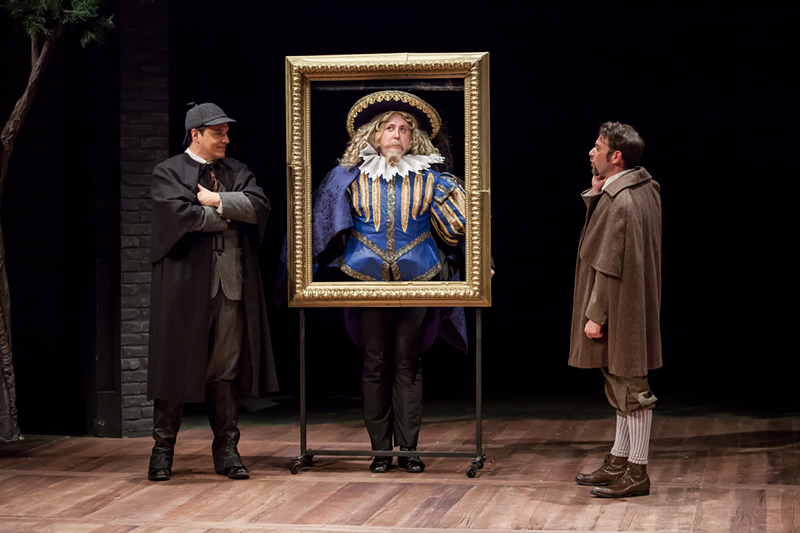The answer to that question is yes, as handily provided by playwright Ken Ludwig with his 2015 script, Baskerville: A Sherlock Holmes Mystery, currently onstage at the Cincinnati Playhouse in the Park. It faithfully renders the story of Holmes and his devoted companion Dr. Watson, sorting out what’s going on at an estate in England’s West Country where Sir Charles Baskerville has recently been mauled to death by a ravenous animal, relighting a fuse of frightened speculation about a hound from hell that’s roamed the moors for years. But Ludwig tells the story through a comic filter. That’s no surprise, since he’s the successful playwright of such award-winning stage comedies as Lend Me a Tenor and Moon Over Buffalo.
That means that from the get-go the interplay is laid on archly between the brilliant Holmes (played with mercurial intensity by Rafael Untalan) and the bumbling but endearing Watson (Jacob James gives him a likeable, earnest nature). Watson calls Holmes “the greatest man I have ever known.” He’s constantly surprised and baffled by his friend’s behavior, even as clues unfold and motives begin to click into place.
But Ludwig didn’t stop there. In Baskerville, the more than 40 other characters who pop in and out of the tale are portrayed by just three actors: Brian Owen, Evan Alexander Smith and Nisi Sturgis. It’s a dazzling display of talent and theatricality with rapid costume and wig changes, sometimes in full view of the audience.
Several of these roles are of Ludwig’s own devising, including Owen as a hilarious, lisping Castilian hotelier, panicked by the notion that anything could be amiss at his establishment, and Sturgis as Mrs. Barrymore, the Eastern European housekeeper at the Baskerville estate who deliriously swaps her w’s and v’s (“Vould you vish der wictuals to be served at vonce, sir?”) as she proffers confusing clues that might or might not shed light on what’s happening.
At other moments, Owen and Sturgis play “Irregulars,” a pair of adolescent street urchins who serve as enthusiastic junior detectives. They’re also the Stapletons, a quirky naturalist and his lovely sister. Smith is most often the lanky, plainspoken Sir Henry Baskerville, the heir who’s come from Texas to claim the estate after Sir Charles’ passing. But he’s also the starchy and mundane Inspector Lestrade.
This legion of characters is outfitted with Lex Liang’s inventive costumes, enabled by a quartet of dressers who implement quick changes (and get their own curtain call). Ludwig includes enough moments of costume and wig madness to constantly remind audiences that this is live theater, as director Brendon Fox emphasizes. In a program note, Fox writes, “To watch an actor transform before our eyes is a treat for a live audience as well as a great way Ken Ludwig shows what our heroes are up against as they try to figure who and what is ‘real’ everywhere they turn.”
That theatrical underscoring is the engine of merriment that fuels Baskerville, which sometimes flies by so quickly you wish you could rewind a scene to watch again. But for audiences, such deliberation isn’t possible as the frenzied action rolls on quickly. (The show is about two and a half hours with a 15-minute intermission.)
Ludwig adds other ingenious moments, including two scenes of opera. In one, from Puccini’s Tosca, Floria Tosca murders the vile Baron Scarpia, a scene Watson suggests reflects “the kind of ruthless murder that had become part of our daily lives.” Later, Holmes, Watson and others sit in a box at Covent Garden to watch Verdi’s Falstaff. Owen (as Shakespeare’s fat jokester) sings, “Tutto nel mondo e burla” — “Everything in the world is a joke.” That’s not quite the coda for Ludwig’s clever version of this classic tale, but it’s certainly a concise description of his approach to telling it and entertaining audiences.
BASKERVILLE: A SHERLOCK HOLMES MYSTERY continues through May 20 at Cincinnati Playhouse in the Park. Tickets/more info: cincyplay.com.


